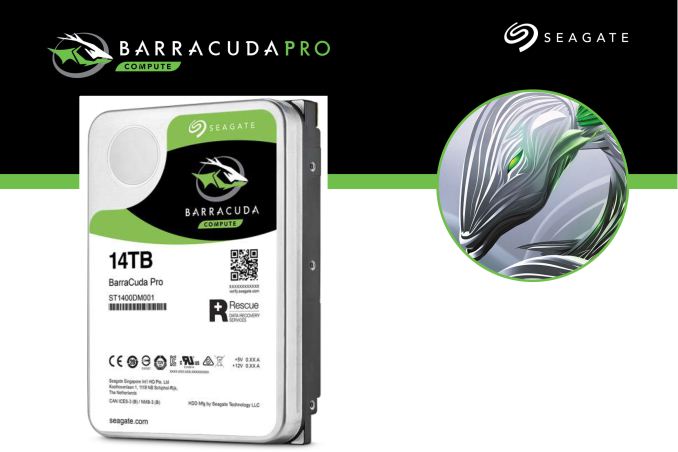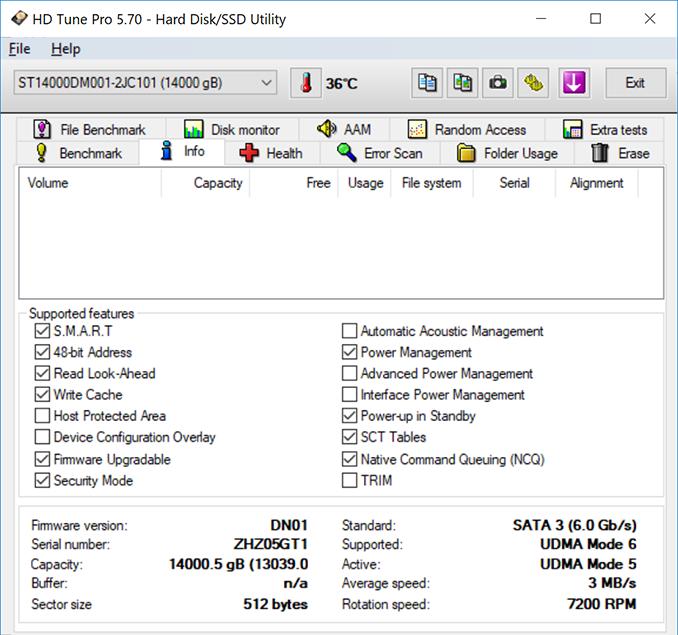Seagate BarraCuda Pro 14TB HDD Review: Massive Storage for Desktops
by Ganesh T S on September 10, 2018 8:01 AM EST
The exponential increase in data storage requirements over the last decade or so has been handled by regular increases in hard drive capacities. Multiple HDD vendors supply them to cloud providers (who get the main benefits from advancements in hard drive technologies), but, Seagate is the only one to also focus on the home consumer / prosumer market. In the last three generations, we have seen that Seagate has been the first to target the desktop storage market with their highest capacity drives. The 10 TB BarraCuda Pro was released in Q3 2016, and the 12 TB version in Q4 2017. Seagate is launching the 14 TB version today.
Introduction
The Seagate BarraCuda Pro 14TB is a 7200RPM SATAIII (6 Gbps) hard drive with a 256MB multi-segmented DRAM cache. It features eight PMR platters with a 1077 Gb/in2 areal density in a sealed enclosure filled with helium. The main change compared to the 12TB version introduced last year is the usage of Seagate's second-generation two-dimensional magnetic recording (TDMR) heads, allowing for higher areal density (1077 Gb/in2 vs. 923 Gb/in2 without TDMR). If you are curious about how TDMR enables this, we have a brief explanation towards the end of this review.
According to Seagate, the 14TB BarraCuda Pro typically draws around 6.9W, making it one of the most power efficient high-capacity 3.5" hard drives in the market. It targets creative professionals with high-performance desktops, home servers and/or direct-attached storage units. It is meant for 24x7 usage (unlike traditional desktop-class hard drives) and carries a workload rating of 300TB/year, backed by a 5-year warranty. The drive also comes with a bundled data-recovery service (available for 2 years from date of purchase). The various aspects of the drive are summarized in the table below.
| Seagate BarraCuda Pro 14TB Specifications | |
| Model Number | ST14000DM0001 |
| Interface | SATA 6 Gbps |
| Sector Size / AF | 512 (Emulated) / 4K Native |
| Rotational Speed | 7200 RPM |
| Cache | 256 MB (Multi-segmented) |
| Platters | 8 |
| Platter Type | PMR |
| Rated Load / Unload Cycles | 300 K |
| Non-Recoverable Read Errors / Bits Read | < 1 in 1015 |
| MTBF | 1M hours |
| Rated Workload | ~ 300 TB/yr |
| Operating Temperature Range | 0 to 60 C |
| Physical Parameters | 14.7 x 10.19 x 2.61 cm; 690 g |
| Warranty | 5 years |
| MSRP (in USD, at launch) | $580 |
With the launch of the 14TB BarraCuda Pro, Seagate has also updated the model numbers for the other capacities in the series. While performance numbers remain relatively unchanged, capacities 10TB and up come in at 690g, while the 8TB is at 650g. The 6TB, however, is at 780g, pointing to different number of platters for different capacities, and even non-helium technology for the smaller ones.
A high-level overview of the various supported SATA features is provided by HD Tune Pro.
The main focus of our evaluation is the performance of the HDD as an internal disk drive in a PC. The other suggested use-case for the BarraCuda Pro is in direct-attached storage devices. The evaluation in these two modes was done with the help of our direct-attached storage testbed.
The internal drive scenario was tested by connecting the drive to one of the SATA ports off the PCH, while the Akitio Thunder3 Duo Pro was used for evaluating the performance in a DAS. The Thunder3 Duo Pro was connected to one of our testbed's Thunderbolt 3 Type-C port. The controller itself connects to the Z170 PCH via a PCIe 3.0 x4 link.
| AnandTech DAS Testbed Configuration | |
| Motherboard | GIGABYTE Z170X-UD5 TH ATX |
| CPU | Intel Core i5-6600K |
| Memory | G.Skill Ripjaws 4 F4-2133C15-8GRR 32 GB ( 4x 8GB) DDR4-2133 @ 15-15-15-35 |
| OS Drive | Samsung SM951 MZVPV256 NVMe 256 GB |
| SATA Devices | Corsair Neutron XT SSD 480 GB Intel SSD 730 Series 480 GB |
| Add-on Card | None |
| Chassis | Cooler Master HAF XB EVO |
| PSU | Cooler Master V750 750 W |
| OS | Windows 10 Pro x64 |
| Thanks to Cooler Master, GIGABYTE, G.Skill and Intel for the build components | |
The full details of the reasoning behind choosing the above build components can be found here.











65 Comments
View All Comments
Ratman6161 - Monday, September 10, 2018 - link
Personally, I would not be using these in a RAID array. I would be using a RAID array of smaller disks that added up to a real world capacity similar to the single drive. With a RAID 5, you could tolerate a single drive failing without data loss.Byte - Monday, September 10, 2018 - link
Since it is a Seagate, that's a lot of data to lose.lorribot - Monday, September 10, 2018 - link
Most Enterprise storage vendors reommend RAID 6 for SATA drives due to their poor fault detecting abilities.What this can mean is when you have a disk in a RAID 5 fail and be replaced, during the 7 days it takes to rebuild your raid the extra load will either break another disk or you will suddenly find you have a undetected dead spot on a drive and your RAID will collapse. Still at least with the Disk recovery service you can get back your data, no wait you raided it so no chance.
Buy one disk and copy/backup to the cloud, no wait only have 0.5Mb/s up link on my fibre internet.......
Diji1 - Tuesday, September 11, 2018 - link
>In the desktop gaming market, per-game storage requirements are running into 100s of GBs, and SSDs continue to remain above $0.20/GB. Under these circumstances, high-capacity hard drives are continuing to remain relevant.I couldn't go back to hard drive storage for gaming.
DanNeely - Tuesday, September 11, 2018 - link
I'd hate to do so too, but not everyone can afford 1 or 2TB SSDs; and smaller sizes don't play nice with >100GB game installs. The flip side is that the semi-common gaming laptop spec of a 256/512GB SSD and 1TB HDD really needs an upgrade to the HDD too. That in turn needs the HDD makers to put out a 2TB 7200 RPM drive at something less than enterprise prices, and figure out how to cram 3TB into the 2.5" form factor in the reasonably near future.Ratman6161 - Tuesday, September 11, 2018 - link
Your wish has been granted. See:https://smile.amazon.com/dp/B01M0AADIX/ref=twister...
DanNeely - Tuesday, September 11, 2018 - link
It's not just that at 15mm they don't fit in laptops, those are 5400rpm drives not 7200. Spinning rust is bad enough under any circumstances, 5400 RPM is unacceptably worse for anything where IO performance matters at all.GTVic - Tuesday, September 11, 2018 - link
14TB, Otherwise known as 12.7TB...cjl - Tuesday, September 11, 2018 - link
14TB. Tera = 10^12, and this drive has 14*10^12 bytes.mapesdhs - Wednesday, September 12, 2018 - link
Yeah, that made me laugh when looking at the benchmark app info in the screenshots. :DGuess I'm old school, brought up with 2^n, but it is funny that the capacities are now so high, the real TB capacity (stuff this decimal nonsense) is more than an entire TB less than it first appears.